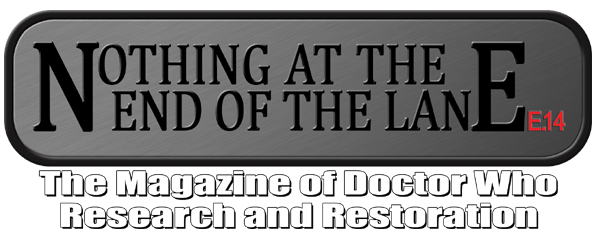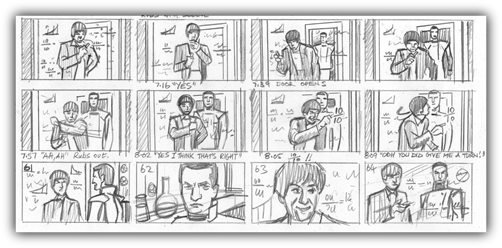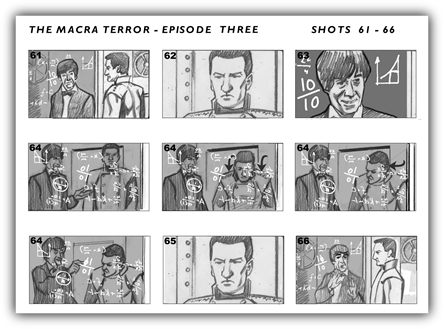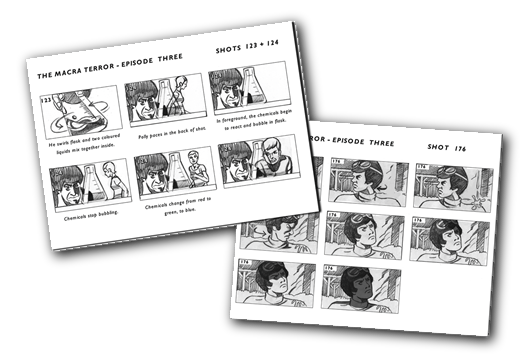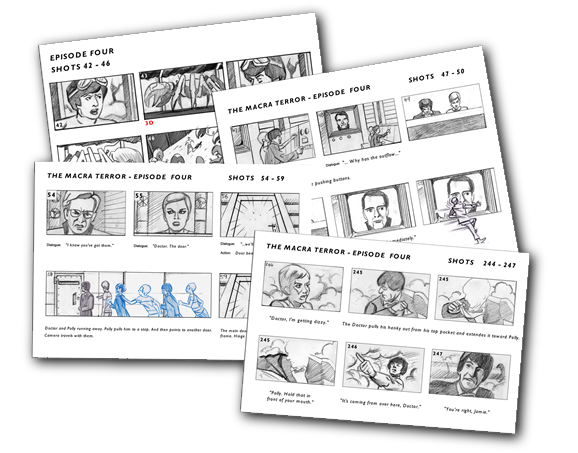
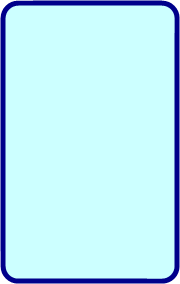
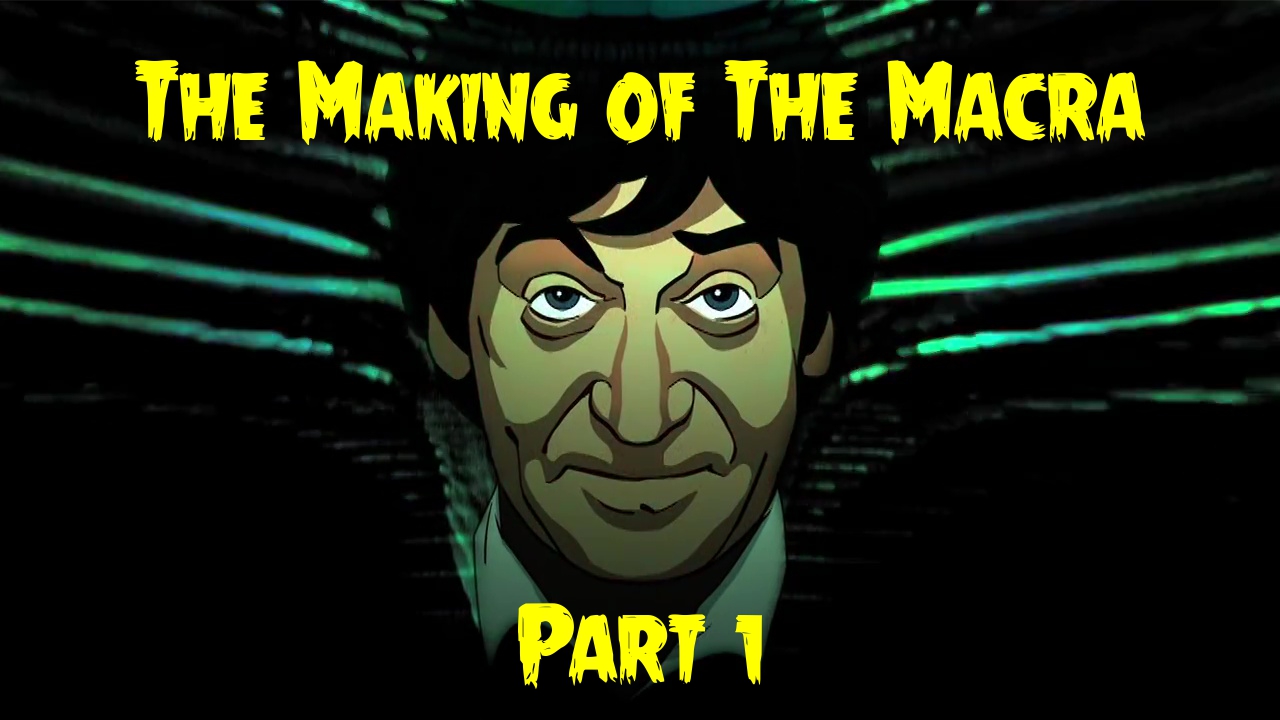
BEGINNINGS • • • • • • • • • • • • • • •
• CHARLES NORTON:
I wasn't going to do another one of these. I really wasn't. The Macra Terror was the fourth animation project that I'd directed for BBC Studios and after quite a few years working pretty solidly on these animations and not very much else, I was fairly confident that we'd probably done the last one.
In fact, my executive producer (Paul Hembury) and I had been relatively certain that we'd be doing something quite different during 2018, as plans were in gestation on a project for BBC Comedy. However, as is often the way, that all fell through rather suddenly and so the idea of one last Doctor Who animation was raised in its stead. And as things have turned out, I can't say that I'm at all sorry about that as it’s been a rare chance to get together again with some very good friends - extremely talented artists and animators among them - and work on a show that we all love very deeply. And there's nothing second-best about that.
The Macra Terror was the seventh story of Doctor Who's fourth television series. Broadcast across four episodes between 11th March and 1st April 1967, it starred Patrick Troughton as the Doctor and was written by Ian Stuart Black. It was a popular story, peaking with around 8.5 million viewers and its reputation still remains high among fans to this day. There was however, one a small problem with The Macra Terror. It didn't exist anymore.
As far as we can work out, the last surviving set of 16mm film prints of the story were probably destroyed in around 1974. The reasons for this are varied and complex and are not something the BBC makes any claim to defend now. Ultimately, there just wasn't a proper television archive at the BBC in 1960s and 70s and The Macra Terror was only one of many casualties of that. The story was last broadcast on ZBS television in Zambia in July 1970. And from that date 'till this, the story has not been broadcast again in any form.
All was not entirely lost, however. Parts of the production had survived in some form. Notably, many Doctor Who fans made their own home-made off-air audio recordings of the story at the time of its one and only UK transmission. In many cases, this involved simply placing a microphone close to their television set and staying very quiet while the programme was on. It was these recordings that have made this new animated reconstruction of the story possible - taking original 1967 audio and creating all new animation to lip-sync up with it. A 2019 production with a 1967 cast.
• CHARLES NORTON:
I wasn't going to do another one of these. I really wasn't. The Macra Terror was the fourth animation project that I'd directed for BBC Studios and after quite a few years working pretty solidly on these animations and not very much else, I was fairly confident that we'd probably done the last one.
In fact, my executive producer (Paul Hembury) and I had been relatively certain that we'd be doing something quite different during 2018, as plans were in gestation on a project for BBC Comedy. However, as is often the way, that all fell through rather suddenly and so the idea of one last Doctor Who animation was raised in its stead. And as things have turned out, I can't say that I'm at all sorry about that as it’s been a rare chance to get together again with some very good friends - extremely talented artists and animators among them - and work on a show that we all love very deeply. And there's nothing second-best about that.
The Macra Terror was the seventh story of Doctor Who's fourth television series. Broadcast across four episodes between 11th March and 1st April 1967, it starred Patrick Troughton as the Doctor and was written by Ian Stuart Black. It was a popular story, peaking with around 8.5 million viewers and its reputation still remains high among fans to this day. There was however, one a small problem with The Macra Terror. It didn't exist anymore.
As far as we can work out, the last surviving set of 16mm film prints of the story were probably destroyed in around 1974. The reasons for this are varied and complex and are not something the BBC makes any claim to defend now. Ultimately, there just wasn't a proper television archive at the BBC in 1960s and 70s and The Macra Terror was only one of many casualties of that. The story was last broadcast on ZBS television in Zambia in July 1970. And from that date 'till this, the story has not been broadcast again in any form.
All was not entirely lost, however. Parts of the production had survived in some form. Notably, many Doctor Who fans made their own home-made off-air audio recordings of the story at the time of its one and only UK transmission. In many cases, this involved simply placing a microphone close to their television set and staying very quiet while the programme was on. It was these recordings that have made this new animated reconstruction of the story possible - taking original 1967 audio and creating all new animation to lip-sync up with it. A 2019 production with a 1967 cast.
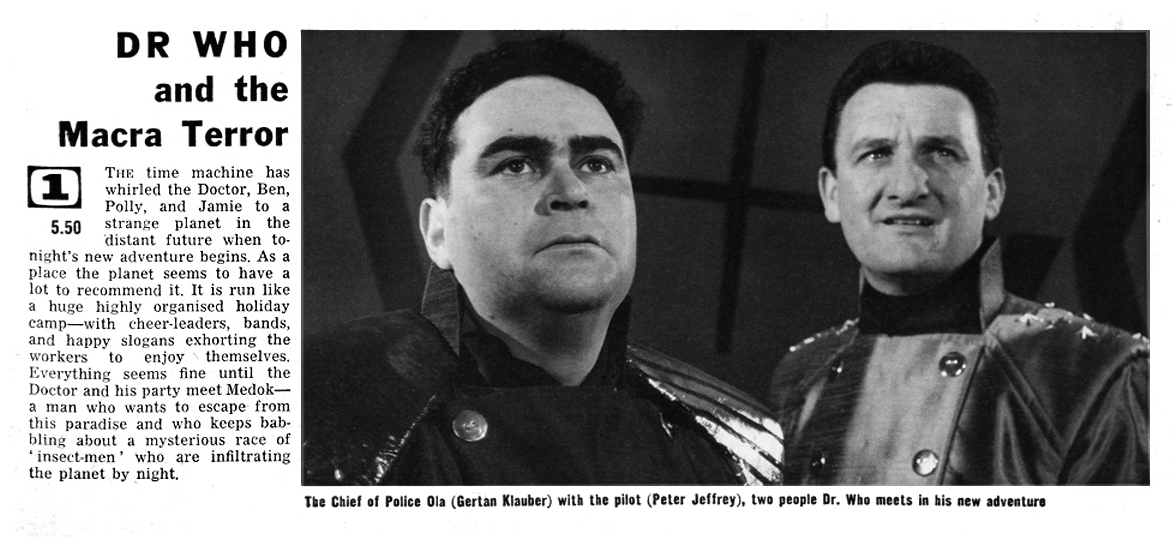

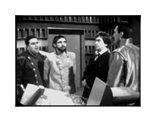
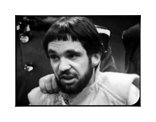
It's a less common production model in the UK, where animation studios normally produce their own shows. However, there are companies who specialise.
Accordingly, we quickly started looking for an animation house, whose facilities we could use on our project. Our first approach was made in mid-February to a company in Manchester and we were in discussion with them for some time. However, for numerous reasons, we were not able to proceed with them in the end. In early March, we approached Sun & Moon Studios in Bristol, with whom we were eventually able to reach an agreement a few weeks later to provide us with the animation services we required. Among the benefits of choosing Sun & Moon was that being based in Bristol, we'd be able to continue using some of the Bristol-resident animators that we'd just finished working with on Shada, namely Chris Bowles and Joanna Hepworth - who both returned to the fold for The Macra Terror.
It was decided that our first move on the project would be to create a short test animation. This would both help stress-test the suitability of the studio and also give Paul some footage he could use to help get the last bit of finance over the line to greenlight the rest of production.
We selected a scene in Episode 3, featuring the characters of the Doctor and Ben. We had worked with the characters before and so had a large stack of character kits already drawn up for them by Martin Geraghty.
Starting on 21st February, I worked with Adrian to storyboard out the sequence for the studio - breaking down exactly what shots we wanted and what movements and expressions we needed within those shots. This storyboard was then edited up to the original audio track in the traditional way to form an animatic, giving the studio the pacing and editing of the required in the sequence.
Accordingly, we quickly started looking for an animation house, whose facilities we could use on our project. Our first approach was made in mid-February to a company in Manchester and we were in discussion with them for some time. However, for numerous reasons, we were not able to proceed with them in the end. In early March, we approached Sun & Moon Studios in Bristol, with whom we were eventually able to reach an agreement a few weeks later to provide us with the animation services we required. Among the benefits of choosing Sun & Moon was that being based in Bristol, we'd be able to continue using some of the Bristol-resident animators that we'd just finished working with on Shada, namely Chris Bowles and Joanna Hepworth - who both returned to the fold for The Macra Terror.
It was decided that our first move on the project would be to create a short test animation. This would both help stress-test the suitability of the studio and also give Paul some footage he could use to help get the last bit of finance over the line to greenlight the rest of production.
We selected a scene in Episode 3, featuring the characters of the Doctor and Ben. We had worked with the characters before and so had a large stack of character kits already drawn up for them by Martin Geraghty.
Starting on 21st February, I worked with Adrian to storyboard out the sequence for the studio - breaking down exactly what shots we wanted and what movements and expressions we needed within those shots. This storyboard was then edited up to the original audio track in the traditional way to form an animatic, giving the studio the pacing and editing of the required in the sequence.
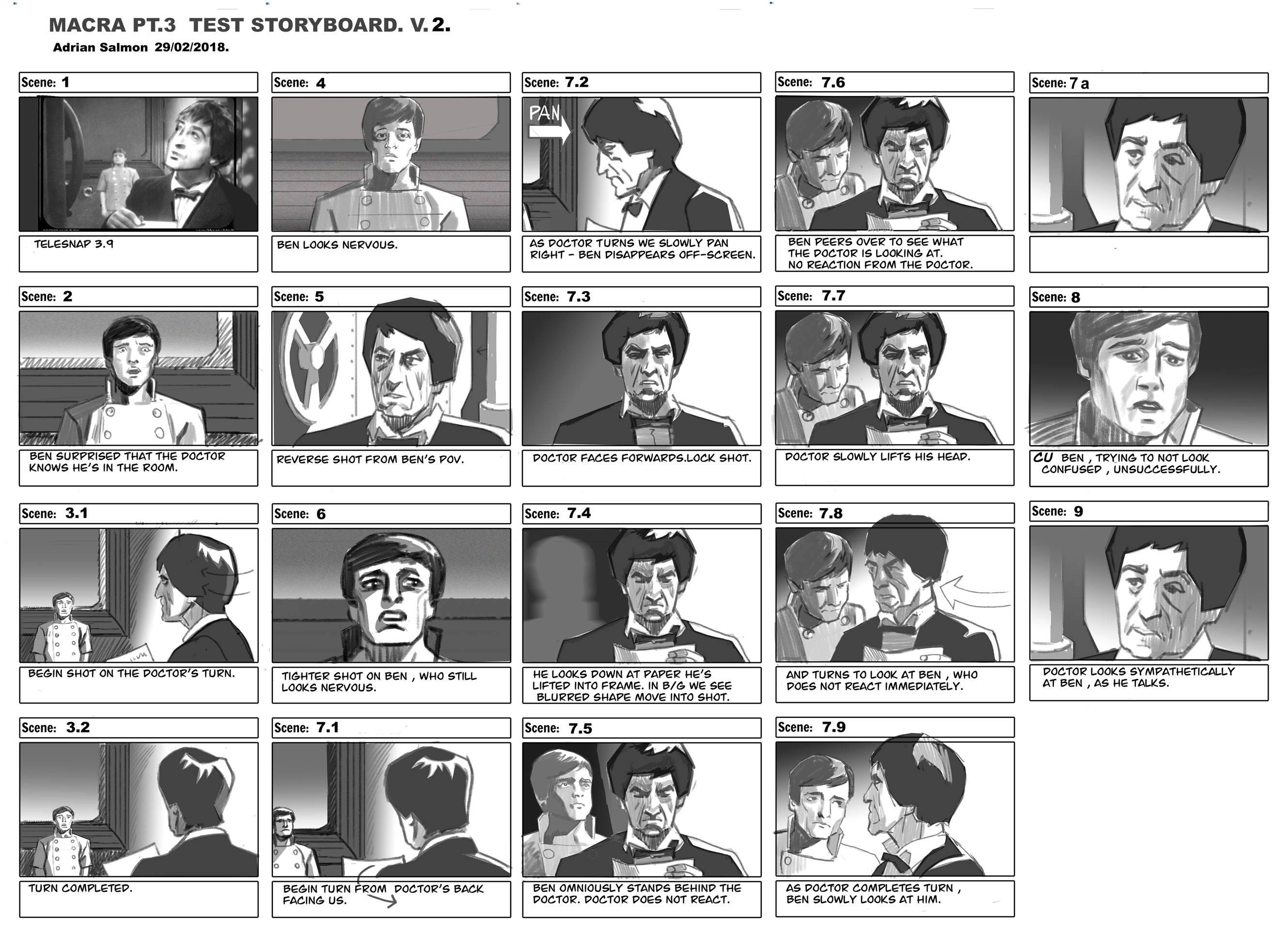
The studio sent over their completed character sequences on 20th March. Our dedicated compositor, Rob Ritchie, then began composing all the elements into a rendered scene. The initial plan was that the test sequence would only include a very rough temporary background. After all, the main point of it was to test out the character animation, so the background was less important and the scene was only really two characters standing in an empty room talking to each other. With this in mind, I cobbled together a rough background plate in Photoshop (using sections taken from some of the background paintings Graham Bleathman had painted for us on Shada, the year before). I then sent it over to Rob for him to use.
As usual however, Rob's enthusiasm knew no bounds. And by the time the studio delivered their elements, he had already created a complete 3D model of the entire set of the pump room in which the scene took place - fully textured with elements lifted from Graham's art and with added effects.
• ROB RITCHIE:
I started by sourcing existing set images of the pump room of which there were some great on-set continuity photographs. I rely on getting as much original design photography as I can, as when I model a set, I’ll do it by eye and there’s lots of subsequent tweaking shapes of walls and props until I get it as close as possible. Originally, I went for a cool blue colour scheme but after talking it through with Charles we figured that red could work much better and with low light levels we could get some nice dynamic shots in that set.
• CHARLES NORTON:
We were a little unhappy with how flat some of the shading was on the initial character animation, so Adrian volunteered to dive in and add some shape to the Doctor's face. He went through frame-by-frame, drawing in some structural shading by hand that added a great deal to the final scene. With that completed, we were left with a pretty respectable minute-long animated scene, which was quickly sent over to Paul.
The finished test sequence was judged to be a success and full production on all four episodes was greenlit in April 2018.
AUDIO RESTORATION • • • • • • • • • • • • • • •
• CHARLES NORTON:
With pre-production now well underway, attention soon turned to the story's audio, upon which the whole of our new production would built. With decades of expertise behind him in getting the best out of the ropiest of recordings, Mark Ayres handled all of our audio work on The Macra Terror.
• MARK AYRES:
As is well-known, all four episodes of The Macra Terror are among the 97 episodes of Doctor Who still missing at the time of writing. Luckily - and frankly, astonishingly - Doctor Who so captured its audience that we have off-air audio recordings of every missing episode. Amazingly, one recordist even captured the very first episode in 1963, including the final few words of the continuity announcer introducing it... but I digress.
The best audio recording of The Macra Terror was made by the late Graham Strong. His recordings were made at 1 7/8 inches-per-second (the same speed as a compact cassette) on 1/4-track, 1/4-inch tape. But whereas most recordists held a microphone in front of the television speaker, Graham had wired his tape recorder directly to his TV's audio circuits, meaning that he captured very high quality audio for the format. All of his tapes had been transferred to digital audio tape at BBC Pebble Mill during the late 1990s, and it was those DATs that were the source of the audio for this animation.
I first remastered The Macra Terror for a CD-released BBC audiobook in 2000, reusing Colin Baker's narration from a previous audio release, which had not used Graham's tapes. I revisited it in 2011 with new narration by Anneke Wills (Polly). At that time I had also corrected the running time of the recordings (the speed at which domestic tape recorders run is not 100% stable), rebuilt the cliff-hangers (Graham tended to miss the music out and pick up each new episode with minimal overlap of the cliff-hangers to save tape), and replaced the opening and closing titles with new copies from the master recordings. It was those masters that were provided to the animation team as reference this time around.
With the animators hard at work, I rebuilt my 2011 sessions from the archive and stripped off all the noise reduction and filtering that I had applied at that time. This was replaced with new mastering based on the latest technology, including multiple layers of very gentle noise reduction, and equalisation modelled on the analog processing used nearer the time of original production. New full-length masters were rendered, which (along with a specially-edited version of the Anneke Wills narration) accompanies the "uncut" telesnap reconstruction on the final product.
As usual however, Rob's enthusiasm knew no bounds. And by the time the studio delivered their elements, he had already created a complete 3D model of the entire set of the pump room in which the scene took place - fully textured with elements lifted from Graham's art and with added effects.
• ROB RITCHIE:
I started by sourcing existing set images of the pump room of which there were some great on-set continuity photographs. I rely on getting as much original design photography as I can, as when I model a set, I’ll do it by eye and there’s lots of subsequent tweaking shapes of walls and props until I get it as close as possible. Originally, I went for a cool blue colour scheme but after talking it through with Charles we figured that red could work much better and with low light levels we could get some nice dynamic shots in that set.
• CHARLES NORTON:
We were a little unhappy with how flat some of the shading was on the initial character animation, so Adrian volunteered to dive in and add some shape to the Doctor's face. He went through frame-by-frame, drawing in some structural shading by hand that added a great deal to the final scene. With that completed, we were left with a pretty respectable minute-long animated scene, which was quickly sent over to Paul.
The finished test sequence was judged to be a success and full production on all four episodes was greenlit in April 2018.
AUDIO RESTORATION • • • • • • • • • • • • • • •
• CHARLES NORTON:
With pre-production now well underway, attention soon turned to the story's audio, upon which the whole of our new production would built. With decades of expertise behind him in getting the best out of the ropiest of recordings, Mark Ayres handled all of our audio work on The Macra Terror.
• MARK AYRES:
As is well-known, all four episodes of The Macra Terror are among the 97 episodes of Doctor Who still missing at the time of writing. Luckily - and frankly, astonishingly - Doctor Who so captured its audience that we have off-air audio recordings of every missing episode. Amazingly, one recordist even captured the very first episode in 1963, including the final few words of the continuity announcer introducing it... but I digress.
The best audio recording of The Macra Terror was made by the late Graham Strong. His recordings were made at 1 7/8 inches-per-second (the same speed as a compact cassette) on 1/4-track, 1/4-inch tape. But whereas most recordists held a microphone in front of the television speaker, Graham had wired his tape recorder directly to his TV's audio circuits, meaning that he captured very high quality audio for the format. All of his tapes had been transferred to digital audio tape at BBC Pebble Mill during the late 1990s, and it was those DATs that were the source of the audio for this animation.
I first remastered The Macra Terror for a CD-released BBC audiobook in 2000, reusing Colin Baker's narration from a previous audio release, which had not used Graham's tapes. I revisited it in 2011 with new narration by Anneke Wills (Polly). At that time I had also corrected the running time of the recordings (the speed at which domestic tape recorders run is not 100% stable), rebuilt the cliff-hangers (Graham tended to miss the music out and pick up each new episode with minimal overlap of the cliff-hangers to save tape), and replaced the opening and closing titles with new copies from the master recordings. It was those masters that were provided to the animation team as reference this time around.
With the animators hard at work, I rebuilt my 2011 sessions from the archive and stripped off all the noise reduction and filtering that I had applied at that time. This was replaced with new mastering based on the latest technology, including multiple layers of very gentle noise reduction, and equalisation modelled on the analog processing used nearer the time of original production. New full-length masters were rendered, which (along with a specially-edited version of the Anneke Wills narration) accompanies the "uncut" telesnap reconstruction on the final product.
STORYBOARDING • • • • • • • • • • • • • • •
• CHARLES NORTON:
The storyboarding phase of an animated production is by far the most important part of the story-telling process. With live-action, you produce your footage and then you edit it. With animation, it's the other way round. You edit it and then you produce your footage. Your storyboard is the entire story in pencil. Every second of the production has to be blocked out and drawn in great detail right at the very start of the project. Long before any animator has animated a single second of character animation, you work out exactly what it's going to look like. In fact, quite a bit of our storyboarding (and character design work) on The Macra Terror was done before we'd even decided on an animation studio.
• CHARLES NORTON:
The storyboarding phase of an animated production is by far the most important part of the story-telling process. With live-action, you produce your footage and then you edit it. With animation, it's the other way round. You edit it and then you produce your footage. Your storyboard is the entire story in pencil. Every second of the production has to be blocked out and drawn in great detail right at the very start of the project. Long before any animator has animated a single second of character animation, you work out exactly what it's going to look like. In fact, quite a bit of our storyboarding (and character design work) on The Macra Terror was done before we'd even decided on an animation studio.
Working with a seasoned director to create storyboards is one thing, but creating them from scratch is quite a different proposition, so when Charles asked me if I wanted to co-direct Episode 3, I jumped at the chance - but not without some apprehension.
Before The Macra Terror was officially commissioned, we had created a short test animation from Episode 3 of the Doctor and Ben in the pump room, so I wasn’t starting with a totally blank slate, there was at least something already completed. I had also been paying attention to how Charles had directed his episodes and was fairly confident I could handle the colony dialogue scenes. To begin with, I listened to Episode 3 quite a few times trying to pick up any stray sounds that would need accompanying actions. I annotated my script the same way that Charles had marked his but it soon became apparent that I had long tracts of background music with no dialogue that I somehow needed to fill with interesting visuals to keep the audiences attention. The dialogue heavy scenes set in the colony buildings were easier to interpret, so I was always looking for the opportunity to spice things up visually, like a reflection or distortion through a glass beaker.
In contrast, when Jamie is trapped wandering in the old mine being harried by monstrous crabs in the dark and creeping green gas, it was Charles’ suggestion that I put myself in Jamie’s boots that finally opened the creative floodgates and I relaxed. I'm not ashamed to say I stole from/was inspired by nearly every monster film I'd ever seen, particularly Alien, which I'd only just watched again. I also wanted to inject a little humour to break the seriousness of it all, so I wheeled out a rusty mining cart, beautifully drawn for us by background artist Colin Howard.
In a very real sense, this is when the programme is actually directed - when the creative decisions that you stick with for the rest of the production are actually made (and never really altered much thereafter).
Most of the production meetings and general office work connected with The Macra Terror were conducted at in the BBC’s offices at Television Centre in London. However, for the storyboard meetings we went elsewhere. With Adrian coming down from Lancashire and me being in Leicestershire, it made more sense for us to meet outside London for the storyboard run-throughs. As neither of us drive, it meant travelling by train - and London's a long journey. Accordingly, I booked a large meeting room at BBC Leicester (above the BBC Radio Leicester studios) and we met there on 20th April for the first of two long days working on the boards together. Me, with 106 pages of hand-written notes and Adrian with a pencil and an awful lot of paper.
• ADRIAN SALMON:
We met at BBC Leicester, a building I was familiar with from when we worked on the Shada animation. Charles brought his laptop and scripts whilst I was armed with my copy of the scripts, pencil and numerous A5 lined notebooks. The plan was to work through as much of Episode 1 and 2 that day as we could and hopefully have time to start Episode 4. The objective of our meeting was for Charles to fully relay over to me exactly how he wanted the story to be directed. My job was to sketch down hundreds of drawings and notes to take back to my studio to work from over the coming months as we prepared the detailed storyboards and animatics required.
I had actually begun the storyboarding process a few weeks prior so I already had some first impression drawings for Charles to see, which helped us get a head start on the first episode. Charles would frequently act out how he saw the characters performing if I was struggling to understand what he wanted in a shot. Each episode is made up of a
Most of the production meetings and general office work connected with The Macra Terror were conducted at in the BBC’s offices at Television Centre in London. However, for the storyboard meetings we went elsewhere. With Adrian coming down from Lancashire and me being in Leicestershire, it made more sense for us to meet outside London for the storyboard run-throughs. As neither of us drive, it meant travelling by train - and London's a long journey. Accordingly, I booked a large meeting room at BBC Leicester (above the BBC Radio Leicester studios) and we met there on 20th April for the first of two long days working on the boards together. Me, with 106 pages of hand-written notes and Adrian with a pencil and an awful lot of paper.
• ADRIAN SALMON:
We met at BBC Leicester, a building I was familiar with from when we worked on the Shada animation. Charles brought his laptop and scripts whilst I was armed with my copy of the scripts, pencil and numerous A5 lined notebooks. The plan was to work through as much of Episode 1 and 2 that day as we could and hopefully have time to start Episode 4. The objective of our meeting was for Charles to fully relay over to me exactly how he wanted the story to be directed. My job was to sketch down hundreds of drawings and notes to take back to my studio to work from over the coming months as we prepared the detailed storyboards and animatics required.
I had actually begun the storyboarding process a few weeks prior so I already had some first impression drawings for Charles to see, which helped us get a head start on the first episode. Charles would frequently act out how he saw the characters performing if I was struggling to understand what he wanted in a shot. Each episode is made up of a
number of shots and each shot comprises a certain number of frames. There were detailed notes scribbled onto a transcript page for each frame and slowly we worked through perhaps 450 or so frames that day. By 5 o'clock my mind was mush, so we bid our goodbyes and retired.
Next morning, after meeting at a different location, the process began anew, but we now had a deadline to get through everything that we'd not managed on the first day. I remember one particular scene that was baffling me. The old man Controller is sat on a stool and as he is dragged out of frame by a giant claw, the camera filming him having tipped over. On the screen you would see him being dragged upwards off-screen which was a nice idea, but I just couldn't get my head around the mechanics of it. Charles brought out his camera and filmed a paper cup standing in for Graham Leaman, until the penny finally dropped. Many months later after we'd finished production, Charles emailed saying he'd found this odd footage from our meeting and did I know what it was?
Armed with the sketches from our meeting and hopefully a good understanding of Charles' interpretation of The Macra Terror, the storyboarding process began in earnest, a month allocated to each episode.
Storyboards are the way the director relays to the animation team precisely what he wants. In animation, They are highly specific and not open to interpretation. They are then put together with the audio soundtrack to form an animatic, which the character animators work from as their guide in creating the character performances.
Working from my sketches, I would begin by drawing up a rough take of a shot, which could cover a number of frames. I would then email this to Charles for discussion and approval. Once any amendments had been made, I would draw the final frames by tracing with a light box and tightening up the drawings, whilst adding the light sources where applicable. I worked numerically through Episode 1, unless a later numbered shot was needed in advance for pre-production work.
Sun & Moon Studios later supplied us with their preferred six frames to a sheet storyboard template, but I tended to draw nine frames to an A4 sheet at the paper stage, which gave me a comfortable drawing size for the deadline. The drawings were then scanned into Photoshop for numbering, notes and any additional digital effects applied before being sent to Charles to assemble and annotate after which, they would then be forwarded to the studio.
To aid me in drawing the storyboards, I first created core character sheets in Photoshop, which showed each actor from as many angles as I could find. I printed these out and used them to help me keep the likenesses consistent, but more specifically, they helped with the various facial expressions I needed to draw. I also made some rudimentary sets out of card and foam board, peopling them with little modellers figures, which I could photograph to better understand the various set-ups and lighting that I was planning.
Rob Ritchie who created our fantastic 3D set designs, supplied me with screenshots to work from and trace, which also helped to greatly speed up my process and add accuracy to the boards.
At this stage of the project the Macra had yet to be redesigned, so inspired by nightmares spawned from Guy N. Smith’s giant crab novels from my youth (and a smelly rubber crab model, which I’d brought along to our Leicester meeting), I drew the Macra as monstrous ravening crustaceans with glowing eyes! Once Martin had brilliantly designed our new Macra, I could then incorporate them into my later storyboards, but for now Polly and Ben had to make do with my sinister seafood cocktail!
The final storyboards for Episode 4 were completed by the end of July, which then left me just over a month for Episode 3.
Next morning, after meeting at a different location, the process began anew, but we now had a deadline to get through everything that we'd not managed on the first day. I remember one particular scene that was baffling me. The old man Controller is sat on a stool and as he is dragged out of frame by a giant claw, the camera filming him having tipped over. On the screen you would see him being dragged upwards off-screen which was a nice idea, but I just couldn't get my head around the mechanics of it. Charles brought out his camera and filmed a paper cup standing in for Graham Leaman, until the penny finally dropped. Many months later after we'd finished production, Charles emailed saying he'd found this odd footage from our meeting and did I know what it was?
Armed with the sketches from our meeting and hopefully a good understanding of Charles' interpretation of The Macra Terror, the storyboarding process began in earnest, a month allocated to each episode.
Storyboards are the way the director relays to the animation team precisely what he wants. In animation, They are highly specific and not open to interpretation. They are then put together with the audio soundtrack to form an animatic, which the character animators work from as their guide in creating the character performances.
Working from my sketches, I would begin by drawing up a rough take of a shot, which could cover a number of frames. I would then email this to Charles for discussion and approval. Once any amendments had been made, I would draw the final frames by tracing with a light box and tightening up the drawings, whilst adding the light sources where applicable. I worked numerically through Episode 1, unless a later numbered shot was needed in advance for pre-production work.
Sun & Moon Studios later supplied us with their preferred six frames to a sheet storyboard template, but I tended to draw nine frames to an A4 sheet at the paper stage, which gave me a comfortable drawing size for the deadline. The drawings were then scanned into Photoshop for numbering, notes and any additional digital effects applied before being sent to Charles to assemble and annotate after which, they would then be forwarded to the studio.
To aid me in drawing the storyboards, I first created core character sheets in Photoshop, which showed each actor from as many angles as I could find. I printed these out and used them to help me keep the likenesses consistent, but more specifically, they helped with the various facial expressions I needed to draw. I also made some rudimentary sets out of card and foam board, peopling them with little modellers figures, which I could photograph to better understand the various set-ups and lighting that I was planning.
Rob Ritchie who created our fantastic 3D set designs, supplied me with screenshots to work from and trace, which also helped to greatly speed up my process and add accuracy to the boards.
At this stage of the project the Macra had yet to be redesigned, so inspired by nightmares spawned from Guy N. Smith’s giant crab novels from my youth (and a smelly rubber crab model, which I’d brought along to our Leicester meeting), I drew the Macra as monstrous ravening crustaceans with glowing eyes! Once Martin had brilliantly designed our new Macra, I could then incorporate them into my later storyboards, but for now Polly and Ben had to make do with my sinister seafood cocktail!
The final storyboards for Episode 4 were completed by the end of July, which then left me just over a month for Episode 3.
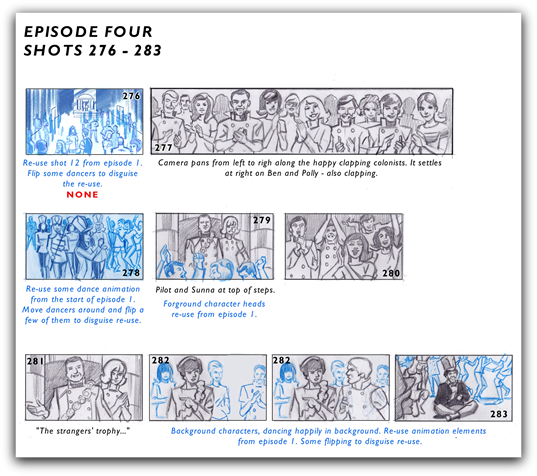
• CHARLES NORTON:
I was rather concerned about Episode 3. There's not a huge amount of dialogue in the episode (when compared to the others) and it's also got an awful lot of scenes that contain no dialogue at all. This was a little tricky, as we had a mostly locked audio track and so we were having to reverse engineer the visuals to try and fit the sound. That's not too hard when you've got some dialogue to hang it around and to use as a rough framework. However, when all you have on the audio are several minutes of shuffles, bumps and thuds, it's not quite so easy.
A large proportion of Episode 3 is made up of Jamie stumbling through dimly lit tunnels being stalked by a giant crab; running into said giant crab; running away from giant crab; hiding from giant crab; finding another giant crab; running away again... You get the idea. After a while of going through a lot of the same such stuff in Episode 4 (which we did before Episode 3), I was soon running rather short of visually creative ways to have someone run away from the Macra. It turns out there really are only so many ways to do it. And with the production ramping up, I also had an eye on how much else there was still to do and how thin I was already being spread.
I was rather concerned about Episode 3. There's not a huge amount of dialogue in the episode (when compared to the others) and it's also got an awful lot of scenes that contain no dialogue at all. This was a little tricky, as we had a mostly locked audio track and so we were having to reverse engineer the visuals to try and fit the sound. That's not too hard when you've got some dialogue to hang it around and to use as a rough framework. However, when all you have on the audio are several minutes of shuffles, bumps and thuds, it's not quite so easy.
A large proportion of Episode 3 is made up of Jamie stumbling through dimly lit tunnels being stalked by a giant crab; running into said giant crab; running away from giant crab; hiding from giant crab; finding another giant crab; running away again... You get the idea. After a while of going through a lot of the same such stuff in Episode 4 (which we did before Episode 3), I was soon running rather short of visually creative ways to have someone run away from the Macra. It turns out there really are only so many ways to do it. And with the production ramping up, I also had an eye on how much else there was still to do and how thin I was already being spread.
With all this in mind, I decided to effectively let Adrian go solo for Episode 3. He would not just draw the boards from my direction (as he did on Episodes 1, 2 and 4). For Episode 3, he'd be pretty much story-directing too. And I'm so glad we did it that way, as it gave the episode an extremely welcome injection of new ideas it would never otherwise have had.
All those creative Macra reveals in the tunnels in Episode 3 were entirely Adrian's and they were all really well staged. He really got it to work so much better than I could ever have hoped for and he thoroughly earned his co-director credit on that episode. His boards for Episode 3 remain among my favourites and it was a joy to cut them together at the animatic stage a few weeks later.
Episode 3 and 4 were largely done in the second half of production as they shared characters and sets that didn’t appear in Episodes 1 and 2, such as the mine workings. It therefore made sense to do Episodes 3 and 4 as a block, or at least, to do the bulk of them together. It was always going to make sense to do things in blocks like that and dividing them this way was the most logical way of splitting them. Within that second block, Episode 3 was left until the very end, as that was the one that Adrian Salmon would be story-directing and as such, he couldn't really start on that until all the boards for the other episodes were completed. So, he boarded Episodes 1,2 and 4 with me at his elbow and then went (largely) solo for Episode 3, while I went off to look after some of the other parts of the production.
• ADRIAN SALMON:
All those creative Macra reveals in the tunnels in Episode 3 were entirely Adrian's and they were all really well staged. He really got it to work so much better than I could ever have hoped for and he thoroughly earned his co-director credit on that episode. His boards for Episode 3 remain among my favourites and it was a joy to cut them together at the animatic stage a few weeks later.
Episode 3 and 4 were largely done in the second half of production as they shared characters and sets that didn’t appear in Episodes 1 and 2, such as the mine workings. It therefore made sense to do Episodes 3 and 4 as a block, or at least, to do the bulk of them together. It was always going to make sense to do things in blocks like that and dividing them this way was the most logical way of splitting them. Within that second block, Episode 3 was left until the very end, as that was the one that Adrian Salmon would be story-directing and as such, he couldn't really start on that until all the boards for the other episodes were completed. So, he boarded Episodes 1,2 and 4 with me at his elbow and then went (largely) solo for Episode 3, while I went off to look after some of the other parts of the production.
• ADRIAN SALMON:
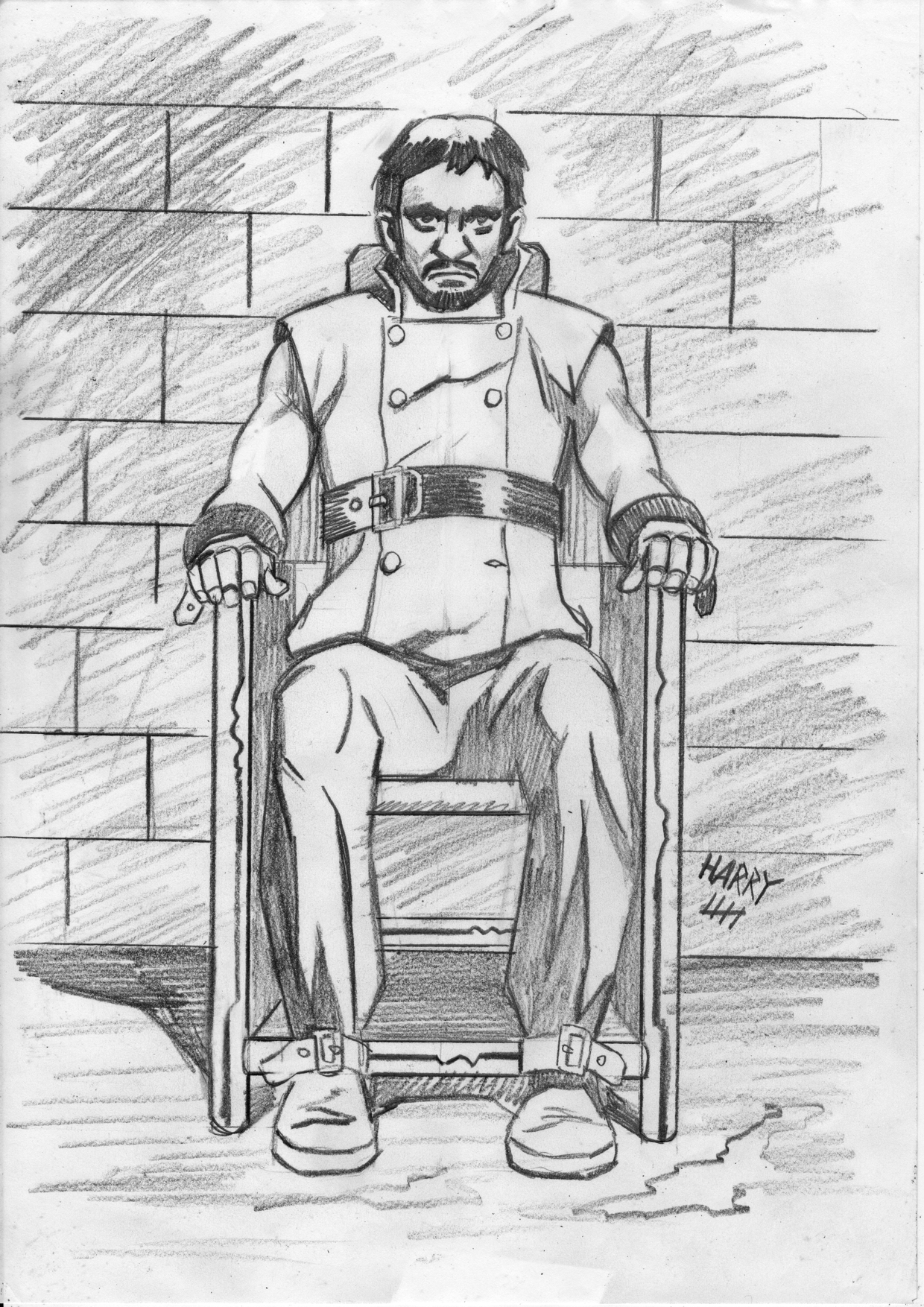
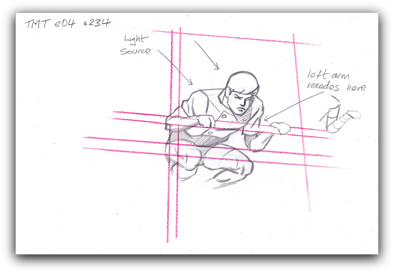
Looking objectively at the final results of Episode 3, I think the sequence where the Doctor is writing his calculations on a see-through plastic board is my most successfully realised scene. In the originally filmed episode, the Doctor writes on a large gas pipe, in fact you can see his chalk scribbling in some of the tele-snaps. When I listened to the audio, I mistook the sounds of him writing for wheels rolling along the floor and the writing board idea was born. I drew very specifically timed boards, showing exactly the Doctor’s mannerisms and movements I wanted him to express for the studio to follow, but I think what helped elevate this scene was that Rob created the chalk calculations first, timing them exactly to the sounds of the Doctor writing, for the animators to sync to.
What we got back from Sun & Moon Studios was a brilliant visual performance from Patrick Troughton, full of nuance and charm, marred only by some weak drawing of the right shoulder, which I attribute to the limitations of Toon Boom, the animation software
What we got back from Sun & Moon Studios was a brilliant visual performance from Patrick Troughton, full of nuance and charm, marred only by some weak drawing of the right shoulder, which I attribute to the limitations of Toon Boom, the animation software
program we used. So, I painstakingly redrew the shoulders frame by frame until I was personally satisfied with the end result. In my storyboards, I originally also had the Pilot creep quietly up behind the Doctor, before the Doctor turns around in surprise, but for some reason the Pilot was never animated walking and that joke lost as the result.
By early September I had completed my last storyboards and they were ready to be turned into the animatic in the BBC edit suite.
By early September I had completed my last storyboards and they were ready to be turned into the animatic in the BBC edit suite.
The idea to produce entirely animated dramas, using the soundtracks of lost television shows was (to say the least) an eccentric one. As a programme format, it doesn't really exist anywhere outside of Doctor Who. Numerous studios and companies have been involved in animating Doctor Who, since the unusual idea was first mooted around 2006. However, the single biggest driver of that endeavour for the last five years has been BBC Studios executive, Paul Hembury.
Paul remains the Doctor Who animation series' most ardent advocate and one of its principal architects. It was Paul who pushed for an animation of The Power of the Daleks to be produced in 2016. It was Paul who pushed for Shada to be produced in 2017. And, most of all, it was Paul who had somehow managed to keep all of us working on these projects moderately sane for the past four years. And that hasn't been easy.
But then, nothing about these projects has ever been easy. They are extremely punishing productions. In order for them to be practical, they have had to be commissioned, produced, fully completed and on-sale within a single financial year. As a result of that, by the time the project has actually been green-lit you can often find yourself with frighteningly little time to actually make the thing. And the deadline is often cast in stone long before you're even close to being given a date to start production.
In addition, due to the tightness of the budgets, you can sometimes find yourself having to be director, producer, production manager and even production accountant all at the same time. With animation being a medium that rapidly eats up time, money and man-power like nothing else, these productions can quickly become traumatic experiences.
It is very hard to cut corners on animation, to find a way of doing it on a limited budget. An inexpensive animation will always look inexpensive. A rushed animation will always look rushed. If you bite off more than you can chew, it will always show. And that's always the battle on projects like these - to achieve something of an acceptable level of quality, without always having the fullest range of resources that might be available to other productions of a comparable scale.
It was for this reason (and a few others) that when Paul first started talking about tackling another of these projects around Christmas 2017, we all had certain reservations. A project of this scale really needed a full year of production time or as close to it as reasonably possible. It ideally needed to have the resources to cover an all-under-one-roof team of character animators. We needed dedicated production and studio managers, so that the director could really just concentrate on actually directing and not everything else. This is far closer to how such shows are run in the States. The way Warner Brothers make their straight-to-DVD Batman animations, for instance. The idea there is to sub-contract out much of the heavy-lifting 'grunt-work' of character animation, leaving your core creative team to concentrate primarily on story direction and design.
However, all of that takes a lot of money and a lot of time. By the end of 2017, I think that the reluctant conclusion many of us had reached was that such a workflow would likely never be possible to achieve on the kind of budget and the kind of schedule we'd need to keep to on a Doctor Who release. It just wasn't reasonable to expect it would ever be financially viable. And so, without any realistic prospect of that infrastructure ever being in place, we all started to move onto other projects as it was clear that nobody would ever be able to assemble the kind of resources needed. Then, against all logical expectation, a few months later, Paul did exactly that.
Somehow he found a way and got us the money and the resources that we needed. Managing to get something off the ground when nobody else can - something that has no reasonable right to ever be off the ground in the first place - is just sort of what Paul does.
• PAUL HEMBURY:
You start from the position that BBC Studios is really a commercial organisation that invests in content. And as with any investment you clearly need to go into it expecting to make a return. So, what you have to do (and what I have to do) is to say to every part of the organisation involved in selling content (and that's quite a large number of people): "This is a piece of content that we'd like to go and make. If we made it, what income do you think you could generate from it?" We get the projections back and compare them to what the piece of content concerned is going to cost to make.
Frankly, this is an organisation that actually finds it easier to say yes than no. It sort of starts from the position of wanting to say yes to investing in content, because that's really the lifeblood of the business. I think that because some of the earlier animated work we did was successful, we were able to say that we could build on that. The business agreed and in the end the money was made available. So, that's how it all came together.
In many ways, it's not much different from any other business that would look at a proposed investment and appraise it. There is also a factor here that Doctor Who is an incredibly important brand for this organisation and if what we're doing supports the brand, then that's helpful to the process as well. And clearly what we are doing is extremely supportive to the brand.
• CHARLES NORTON:
Around the start of 2018, Paul got in touch to say that he thought we could actually do it. He thought he could find a way, not just to get the money together, but to give us the kind of resources that would mean I wouldn't have to do five jobs at once. Which would be nice.
We’d have a per-episode budget that would be significantly larger than that we’d been allocated when we'd produced The Power of the Daleks in 2016 and much more importantly, the amount of time we'd have to complete production would be effectively doubled. Animating The Macra Terror would be a significantly less stressful proposition than such projects had perhaps been in the past. Well... at least in theory.
PRE-PRODUCTION • • • • • • • • • • • • • • •
• CHARLES NORTON:
Work on our new animated production of The Macra Terror essentially began in February 2018. The first to join myself and Paul on the project were our regular storyboard artist Adrian Salmon and character artist Martin Geraghty.
Martin was drawing a comic strip for Doctor Who Magazine until a bit later into the year, so to begin with, it was pretty much just me and Adrian for those first few months. There were still some questions marks about exactly when the project would officially be starting, with Paul continuing to talk to BBC America about their end of things for a few weeks. However, we knew that we'd be starting at some point and so it was during this time that I began work marking up my script, blocking out the shots and deciding how we'd go about structuring the production.
Paul remains the Doctor Who animation series' most ardent advocate and one of its principal architects. It was Paul who pushed for an animation of The Power of the Daleks to be produced in 2016. It was Paul who pushed for Shada to be produced in 2017. And, most of all, it was Paul who had somehow managed to keep all of us working on these projects moderately sane for the past four years. And that hasn't been easy.
But then, nothing about these projects has ever been easy. They are extremely punishing productions. In order for them to be practical, they have had to be commissioned, produced, fully completed and on-sale within a single financial year. As a result of that, by the time the project has actually been green-lit you can often find yourself with frighteningly little time to actually make the thing. And the deadline is often cast in stone long before you're even close to being given a date to start production.
In addition, due to the tightness of the budgets, you can sometimes find yourself having to be director, producer, production manager and even production accountant all at the same time. With animation being a medium that rapidly eats up time, money and man-power like nothing else, these productions can quickly become traumatic experiences.
It is very hard to cut corners on animation, to find a way of doing it on a limited budget. An inexpensive animation will always look inexpensive. A rushed animation will always look rushed. If you bite off more than you can chew, it will always show. And that's always the battle on projects like these - to achieve something of an acceptable level of quality, without always having the fullest range of resources that might be available to other productions of a comparable scale.
It was for this reason (and a few others) that when Paul first started talking about tackling another of these projects around Christmas 2017, we all had certain reservations. A project of this scale really needed a full year of production time or as close to it as reasonably possible. It ideally needed to have the resources to cover an all-under-one-roof team of character animators. We needed dedicated production and studio managers, so that the director could really just concentrate on actually directing and not everything else. This is far closer to how such shows are run in the States. The way Warner Brothers make their straight-to-DVD Batman animations, for instance. The idea there is to sub-contract out much of the heavy-lifting 'grunt-work' of character animation, leaving your core creative team to concentrate primarily on story direction and design.
However, all of that takes a lot of money and a lot of time. By the end of 2017, I think that the reluctant conclusion many of us had reached was that such a workflow would likely never be possible to achieve on the kind of budget and the kind of schedule we'd need to keep to on a Doctor Who release. It just wasn't reasonable to expect it would ever be financially viable. And so, without any realistic prospect of that infrastructure ever being in place, we all started to move onto other projects as it was clear that nobody would ever be able to assemble the kind of resources needed. Then, against all logical expectation, a few months later, Paul did exactly that.
Somehow he found a way and got us the money and the resources that we needed. Managing to get something off the ground when nobody else can - something that has no reasonable right to ever be off the ground in the first place - is just sort of what Paul does.
• PAUL HEMBURY:
You start from the position that BBC Studios is really a commercial organisation that invests in content. And as with any investment you clearly need to go into it expecting to make a return. So, what you have to do (and what I have to do) is to say to every part of the organisation involved in selling content (and that's quite a large number of people): "This is a piece of content that we'd like to go and make. If we made it, what income do you think you could generate from it?" We get the projections back and compare them to what the piece of content concerned is going to cost to make.
Frankly, this is an organisation that actually finds it easier to say yes than no. It sort of starts from the position of wanting to say yes to investing in content, because that's really the lifeblood of the business. I think that because some of the earlier animated work we did was successful, we were able to say that we could build on that. The business agreed and in the end the money was made available. So, that's how it all came together.
In many ways, it's not much different from any other business that would look at a proposed investment and appraise it. There is also a factor here that Doctor Who is an incredibly important brand for this organisation and if what we're doing supports the brand, then that's helpful to the process as well. And clearly what we are doing is extremely supportive to the brand.
• CHARLES NORTON:
Around the start of 2018, Paul got in touch to say that he thought we could actually do it. He thought he could find a way, not just to get the money together, but to give us the kind of resources that would mean I wouldn't have to do five jobs at once. Which would be nice.
We’d have a per-episode budget that would be significantly larger than that we’d been allocated when we'd produced The Power of the Daleks in 2016 and much more importantly, the amount of time we'd have to complete production would be effectively doubled. Animating The Macra Terror would be a significantly less stressful proposition than such projects had perhaps been in the past. Well... at least in theory.
PRE-PRODUCTION • • • • • • • • • • • • • • •
• CHARLES NORTON:
Work on our new animated production of The Macra Terror essentially began in February 2018. The first to join myself and Paul on the project were our regular storyboard artist Adrian Salmon and character artist Martin Geraghty.
Martin was drawing a comic strip for Doctor Who Magazine until a bit later into the year, so to begin with, it was pretty much just me and Adrian for those first few months. There were still some questions marks about exactly when the project would officially be starting, with Paul continuing to talk to BBC America about their end of things for a few weeks. However, we knew that we'd be starting at some point and so it was during this time that I began work marking up my script, blocking out the shots and deciding how we'd go about structuring the production.
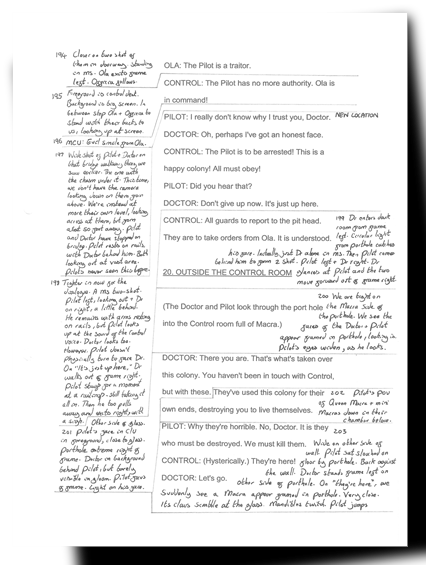
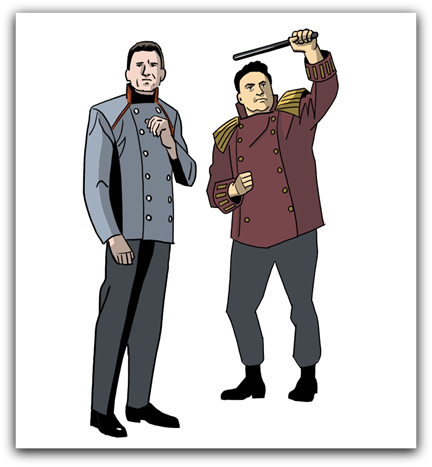
Adrian meanwhile started to look through the characters that he'd be drawing for the boards and began breaking down the principals. It was also around this time that the first piece of artwork was completed - a small colour study by Adrian. This established very early on what the colour palette would be both for the costumes and the sets in the main body of the story. Our episodes were set in a sort of Kafkaesque holiday camp of enforced jollity and faded concrete. With that in mind, we went for a sort of pale blue as a key colour - trying to suggest that everyone's clothes had been through the washing machine too many times and that all the dyes had faded. A washed-out world of that had lost all its sparkle.
We were keen to use some of the same animators that we'd worked with on our earlier animations (people like the ever-brilliant Joanna Hepworth, for instance). However, rather than have everyone work from home, the plan this time around was to have all the animators under one roof - managed by a sub-contracted studio, who would provide to us the resources of a physical studio space where most of the 2D animators would be housed.
The industry term for this is 'service animation'. It's how most major animation shows are made in America, including The Simpsons, Family Guy and Rick and Morty. It normally involves studios in Hollywood (like Fox), partnering with studios in South Korea (like AKOM). The creative and editorial side is managed in the US, where the story direction is done, with detailed animatics then being sent to Korea, where a room full of people do an awful lot of drawing to make it into a finished product.
We were keen to use some of the same animators that we'd worked with on our earlier animations (people like the ever-brilliant Joanna Hepworth, for instance). However, rather than have everyone work from home, the plan this time around was to have all the animators under one roof - managed by a sub-contracted studio, who would provide to us the resources of a physical studio space where most of the 2D animators would be housed.
The industry term for this is 'service animation'. It's how most major animation shows are made in America, including The Simpsons, Family Guy and Rick and Morty. It normally involves studios in Hollywood (like Fox), partnering with studios in South Korea (like AKOM). The creative and editorial side is managed in the US, where the story direction is done, with detailed animatics then being sent to Korea, where a room full of people do an awful lot of drawing to make it into a finished product.
 from the original (lost) 1967 production of 'The Macra Terror'. Pictured are actors Terence Lodge and Patrick Troughton..png)
